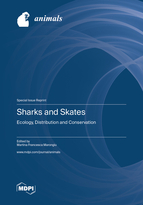Sharks and Skates: Ecology, Distribution and Conservation
A special issue of Animals (ISSN 2076-2615). This special issue belongs to the section "Ecology and Conservation".
Deadline for manuscript submissions: closed (1 March 2023) | Viewed by 62095
Special Issue Editor
Special Issue Information
Dear Colleagues,
Chondrichthyans (sharks, skates, rays and chimaeras) represent one of the oldest and most ecologically various vertebrate lineages. This group of predators occupy the top of aquatic food webs and play an important functional role in the control of coastal and oceanic ecosystem structure and function. However, nowadays, overfishing and habitat degradation are altering their populations leading to a worrisome decline of these species worldwide because of their low resilience. Moreover, data on the stock status of this important resource remain still poor or non-existent, which is due to a problematic taxonomy (e.g., misidentification issues).
In this Special Issue, we invite contributions that investigate the life histories of Chondrichthyans (e.g., reproduction, age and growth), trophic ecology, genetic information and updated data on their distribution in order to collect information that is helpful to develop conservation plans for these marine predators.
Topics may include, but are not limited to, species inhabiting coastal waters, transitional waters (e.g., freshwaters), oceans, deep seas, pelagic and bottom environments.
Dr. Martina Francesca Marongiu
Guest Editor
Manuscript Submission Information
Manuscripts should be submitted online at www.mdpi.com by registering and logging in to this website. Once you are registered, click here to go to the submission form. Manuscripts can be submitted until the deadline. All submissions that pass pre-check are peer-reviewed. Accepted papers will be published continuously in the journal (as soon as accepted) and will be listed together on the special issue website. Research articles, review articles as well as short communications are invited. For planned papers, a title and short abstract (about 100 words) can be sent to the Editorial Office for announcement on this website.
Submitted manuscripts should not have been published previously, nor be under consideration for publication elsewhere (except conference proceedings papers). All manuscripts are thoroughly refereed through a single-blind peer-review process. A guide for authors and other relevant information for submission of manuscripts is available on the Instructions for Authors page. Animals is an international peer-reviewed open access semimonthly journal published by MDPI.
Please visit the Instructions for Authors page before submitting a manuscript. The Article Processing Charge (APC) for publication in this open access journal is 2400 CHF (Swiss Francs). Submitted papers should be well formatted and use good English. Authors may use MDPI's English editing service prior to publication or during author revisions.
Keywords
- cartilaginous fish
- conservation biology and ecology
- population genetics
- management
- oceans
- shallow waters
- deep sea
- freshwaters







